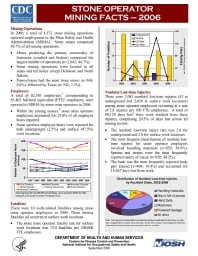Mining Publication: Stone Operator Mining Facts - 2006
Original creation date: September 2008
Authors: National Institute for Occupational Safety and Health
NIOSHTIC2 Number: 20034773
Pittsburgh, PA: U.S. Department of Health and Human Services, Public Health Service, Centers for Disease Control and Prevention, National Institute for Occupational Safety and Health, DHHS (NIOSH) Publication No. 2008-162, 2008 Sep; :1-2
Mining Operations: In 2006, a total of 4,573 stone mining operations reported employment to the Mine Safety and Health Administration (MSHA). Stone mines comprised 30.7% of all mining operations. Mines producing the primary commodity of limestone (crushed and broken) comprised the largest number of operations (n=2,042; 44.7%). Stone mining operations were located in all states and territories except Delaware and North Dakota. Pennsylvania had the most stone mines (n=368; 8.0%), followed by Texas (n=342; 7.5%). Employees: A total of 82,583 employees, corresponding to 85,402 full-time equivalent (FTE) employees, were reported to MSHA by stone mine operators in 2006. Within the mining sectors, stone mine operator employees accounted for 25.8% of all employee hours reported. Stone operator employee hours were reported for both underground (2.5%) and surface (97.5%) work locations. Fatalities: There were 10 work-related fatalities among stone mine operator employees in 2006. These mining fatalities all occurred at surface work locations. The stone mine operator fatality rate for surface work locations was 13.4 fatalities per 100,000 FTE employees. Nonfatal Lost-time Injuries: There were 2,081 nonfatal lost-time injuries (43 at underground and 2,038 at surface work locations) among stone operator employees occurring at a rate of 2.8 injuries per 100 FTE employees. A total of 90,129 days lost from work resulted from these injuries, comprising 20.5% of days lost across all mining sectors. The nonfatal lost-time injury rate was 2.0 for underground and 2.8 for surface work locations. The most frequent classification of nonfatal lost-time injuries for stone operator employees involved handling materials (n=829; 39.8%). Sprains and strains were the most frequently reported nature of injury (n=920; 44.2%). The back was the most frequently reported body part injured (n=404; 19.4%) and accounted for 15,647 days lost from work.

NIOSHTIC2 Number: 20034773
Pittsburgh, PA: U.S. Department of Health and Human Services, Public Health Service, Centers for Disease Control and Prevention, National Institute for Occupational Safety and Health, DHHS (NIOSH) Publication No. 2008-162, 2008 Sep; :1-2
- Coal and metal/nonmetal mining facts - 2008
- Coal and Metal/Nonmetal Mining Facts - 2008 (HTML)
- Coal Contractor Mining Facts - 2001
- Coal Contractor Mining Facts - 2002
- Coal Contractor Mining Facts - 2003
- Coal Contractor Mining Facts - 2004
- Coal Contractor Mining Facts - 2005
- Coal Contractor Mining Facts - 2006
- Mining Fact Sheets
- Rib Falls: A Major Ground Control Issue